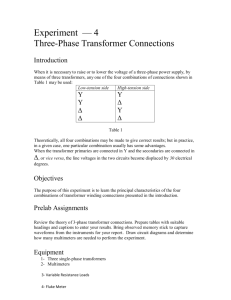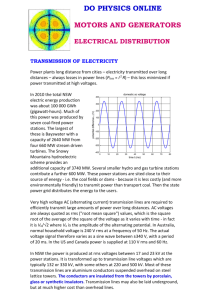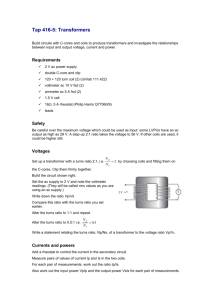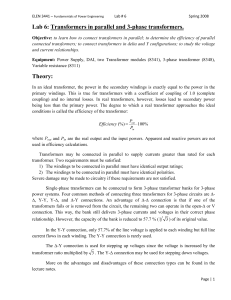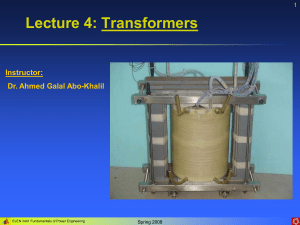Lab 5: Single-phase transformer operations. Theory: Experiment:
advertisement
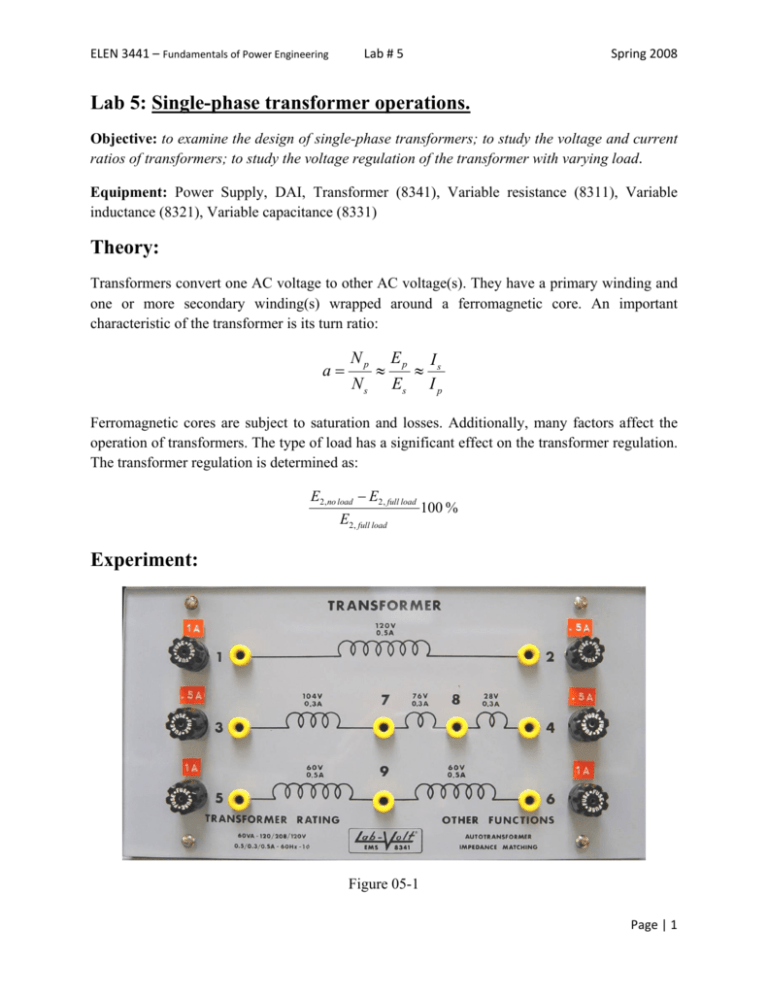
ELEN 3441 – Fundamentals of Power Engineering Lab # 5 Spring 2008 Lab 5: Single-phase transformer operations. Objective: to examine the design of single-phase transformers; to study the voltage and current ratios of transformers; to study the voltage regulation of the transformer with varying load. Equipment: Power Supply, DAI, Transformer (8341), Variable resistance (8311), Variable inductance (8321), Variable capacitance (8331) Theory: Transformers convert one AC voltage to other AC voltage(s). They have a primary winding and one or more secondary winding(s) wrapped around a ferromagnetic core. An important characteristic of the transformer is its turn ratio: a= Np Ns ≈ Ep Es ≈ Is Ip Ferromagnetic cores are subject to saturation and losses. Additionally, many factors affect the operation of transformers. The type of load has a significant effect on the transformer regulation. The transformer regulation is determined as: E2, no load − E2, full load E2, full load 100 % Experiment: Figure 05-1 Page | 1 ELEN 3441 – Fundamentals of Power Engineering Lab # 5 Spring 2008 Observe that the transformer used in this experiment has three windings: 1-2, 3-4, and 5-6. The rated voltages between the terminals are listed on the front panel of the transformer module. 1) Construct the circuit shown in Figure 05-2: Figure 05-2 After verification of correct wiring, turn ON the PS and adjust the input voltage to 120 V AC. Measure the voltage between the transformer’s terminals 5-6. Without turning OFF the power and re-adjusting the input voltage, carefully measure and record voltages between the following terminals: 5-9, 9-6, 3-4, 3-7, 7-8, and 8-4. Are voltages you measured approximately equal to the rated values? If not, report to the instructor. 2) To determine the effect of core saturation, construct the circuit shown in Figure 05-3: Figure 05-3 Page | 2 ELEN 3441 – Fundamentals of Power Engineering Lab # 5 Spring 2008 Observe that the primary transformer’s winding is connected to different terminals of the PS. Turn ON the PS and adjust the input voltage to 25 V AC. Record the values for primary and secondary voltages and primary current to a Data table. Repeat similar measurements for different input voltages from approximately 50 V to approximately 200 V with steps of approximately 25 V. Record values for each measurement to your Data table. 3) We will study next the importance of polarity of windings. Construct the circuit illustrated in Figure 05-4. Observe that the input voltage is supplied this time to another winding, i.e. 3-4. Figure 05-4 Observe that the windings 1-2 and 5-6 are connected in series. After verification of correct wiring, apply an input voltage of approximately 104 V AC. The input voltage can be controlled by the PS voltmeter. Measure and record the voltages across the following terminals: 1-2, 5-6, and 2-6. Turn OFF the PS and rewire the circuit as shown in Figure 05-5. Page | 3 ELEN 3441 – Fundamentals of Power Engineering Lab # 5 Spring 2008 Figure 05-5 After verification of correct wiring, apply an input voltage of approximately 104 V AC. Measure and record the voltages across the following terminals: 1-2, 5-6, and 2-5. 4) To study the transformer regulation, construct the circuit shown in Figure 05-6. Figure 05-6 Using a resistive load (a Variable resistance module) with all the switches in the OFF position, turn ON the PS and adjust the input voltage to 120 V. For the following set of load resistances: ∞ (all switches are OFF), 1200 Ω, 600 Ω, 400 Ω (1200 Ω and 600 Ω in parallel), 300 Ω, and 200 Ω (600 Ω and 300 Ω in parallel) measure Page | 4 ELEN 3441 – Fundamentals of Power Engineering Lab # 5 Spring 2008 primary and secondary voltages and currents. Record the values for each measurement in a Data table. 5) Replace the resistive load by an inductive load (a Variable inductance module). With all the switches in the OFF position, turn ON the PS and adjust the input voltage to 120 V. For the following set of load reactances: ∞ (all switches are OFF), 1200 Ω, 600 Ω, 400 Ω (1200 Ω and 600 Ω in parallel), 300 Ω, and 200 Ω (600 Ω and 300 Ω in parallel) measure primary and secondary voltages and currents. Record the values for each measurement in another Data table. 6) Replace the inductive load by a capacitive load (a Variable capacitance module). With all the switches in the OFF position, turn ON the PS and adjust the input voltage to 120 V. For the following set of load reactances: ∞ (all switches are OFF), 1200 Ω, 600 Ω, 400 Ω (1200 Ω and 600 Ω in parallel), 300 Ω, and 200 Ω (600 Ω and 300 Ω in parallel) measure primary and secondary voltages and currents. Record the values for each measurement in another Data table. In your report: 1. For the voltages you have measured in Part 1, determine the approximate turn ratios between the primary winding 1-2 and the windings 3-4 and 5-6. Using the estimated turn ratios and assuming that the primary winding (1-2) has 500 turns, determine turn numbers for the secondary windings 3-4 and 5-6. Comment on accuracy of such estimation. Discuss possible sources of errors associated with this experimental procedure. Please, be more specific than just mentioning “machine accuracy” and “human error”! 2. Import the data you have collected in Part 2 to Matlab and plot a dependence of the primary winding’s voltage on the primary current, i.e. E1 vs. I1. Observe that the primary current is a magnetization current. Discuss the graph. 3. For the data collected in Part 3, explain why the voltage with the two winding in series is approximately zero in one case and nearly 120 V in the other. Which terminals have the same polarity? 4. Import the data you have collected in Parts 4, 5, and 6 to Matlab and plot a dependence of the secondary winding’s voltage on the secondary current, i.e. E2 vs. I2, on the same axes for all three types of the load. Clearly label each graph. Discuss the graphs you obtained. For each load, calculate the transformer regulation. Is the power in the primary winding equal to the power in the secondary winding? Discuss possible sources for such inequality. Page | 5

